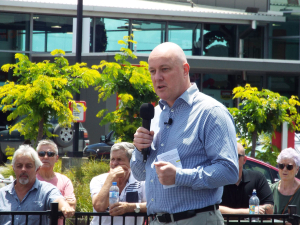What’s more, the flipside is it should help identify where production might be intensified without causing unacceptable consequences to the farm’s environmental footprint.
Branded MitAgator, the package is being promoted by fertiliser cooperative Ballance Agri-Nutrients which, with the help of Government money from the Primary Growth Partnership, has been working with AgResearch on it.
It takes data from Overseer and links it with a geo-referenced farm map, soil map and digital elevation model.
“It’s a decision support tool that will help farmers make more objective decisions,” Ballance R&D manager Warwick Catto told Rural News. “Overseer gives you a [nutrient loss] number but it doesn’t tell you spatially what to do about it.”
MitAgator does, generating maps showing areas at high risk of N, P, sediment and/or bacterial loss. “Once the base risk maps are developed, mitigation and management strategies can be modelled, and can be targeted to an individual paddock, or even part of it.”
Options might include riparian planting, buffer zones, use of low solubility fertilisers. Typical costs and likely efficacy of each are given.
Catto stresses the programme is a management tool, not a regulatory one. “The way Overseer is being used at the moment the last thing the farmer needs is another set of numbers. This is about the relative changes that doing certain things will achieve. We’re not so worried about the absolute numbers as we are with Overseer.”
Despite those comments, he denies the inspiration for MitAgator was because Overseer has been hijacked by regulators.
“We became involved with this four or five years ago when there was a huge focus on nitrogen (Overseer’s forte). We felt it important that phosphate, sediment and e-coli be considered as well.”
While a farm-ready version of the tool won’t be available until the end of next year, a prototype is being tested and proofed with data from over a dozen farms nationwide.
With 80% of a farm’s nutrient losses often occurring from just 20% of a farm’s area, Catto stresses it’s far more cost effective to target mitigation and management to those key areas. Working with Overseer and using extra data on soil and topography, Mitigator shows how to do that.
“It will help farmers to minimise losses while getting better use efficiency from their phosphate (P) and nitrogen (N) fertiliser….
“This has great potential benefits in helping farmers to continue farming within nutrient-restricted catchments.”
A next step with the model is to integrate it with other data sources to allow real-time risk management, such as cross-referencing soil moisture data and forecast rain to decide whether to graze stock or irrigate effluent on a paddock or area of the farm.

















